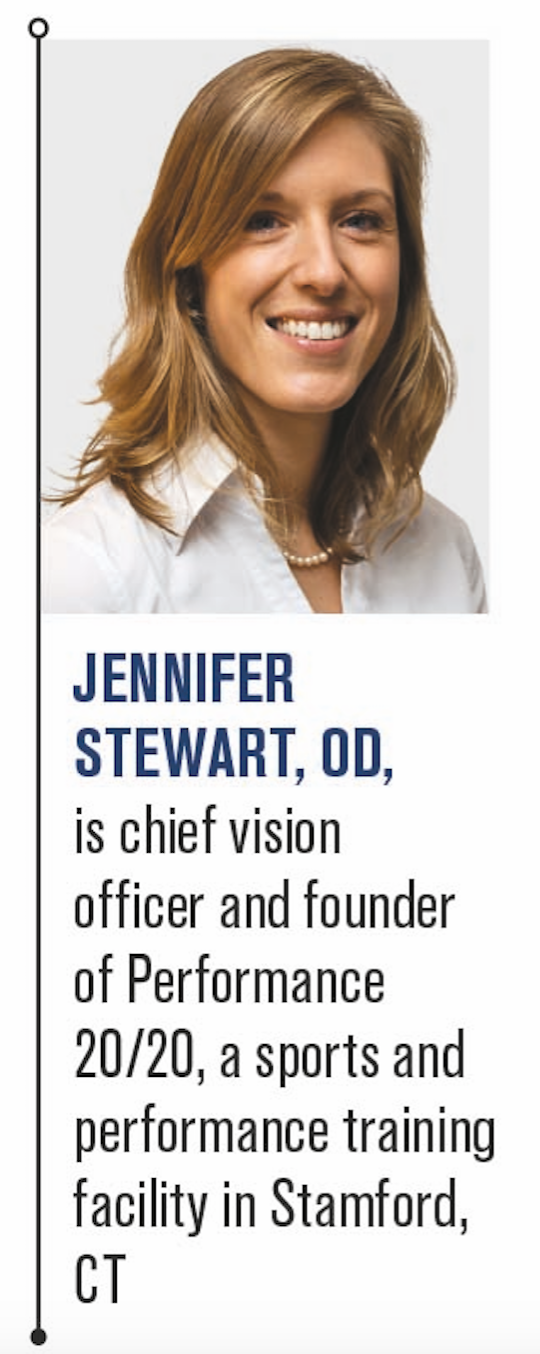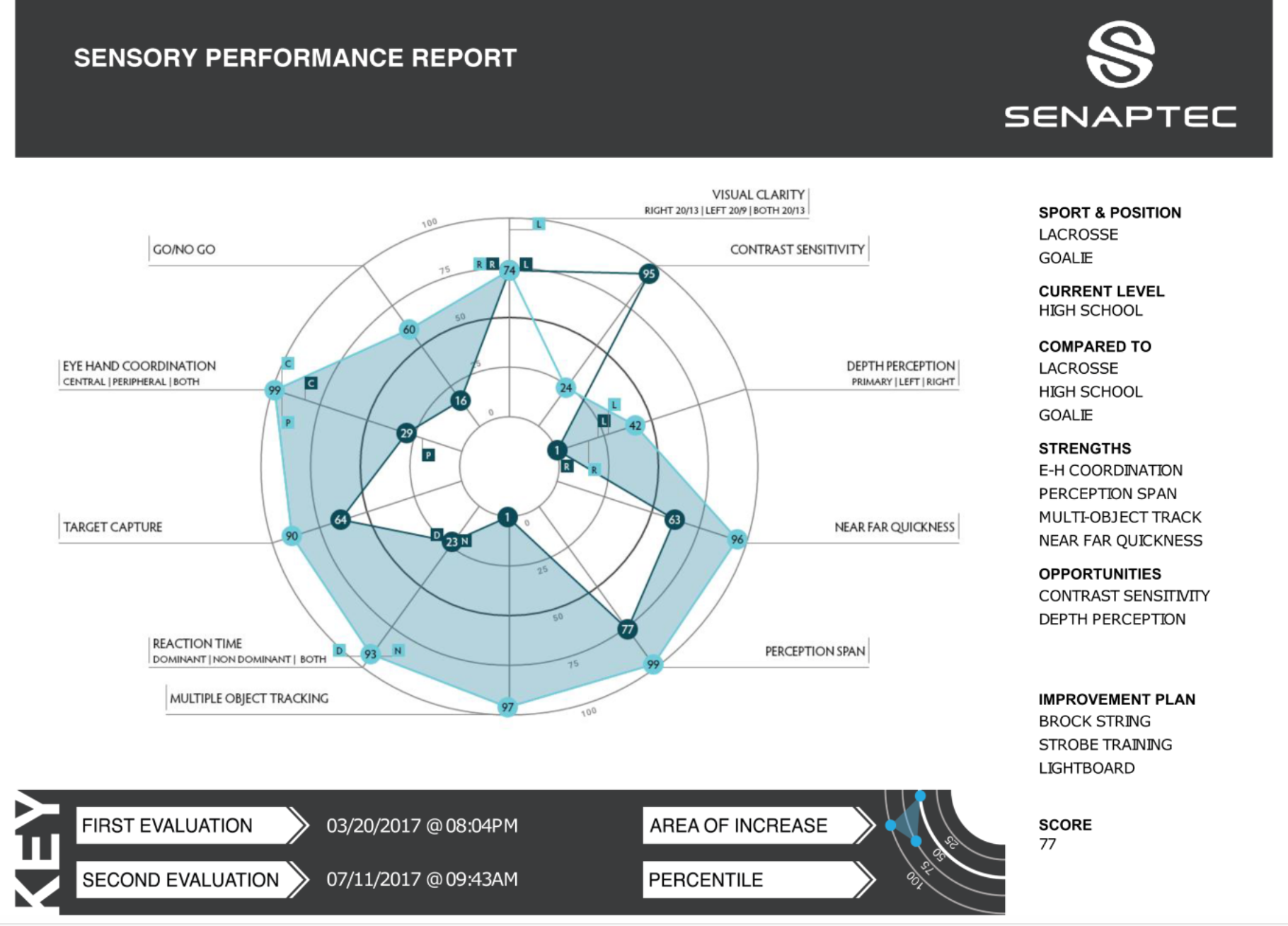8 tips to add sports and performance vision to your practice

Figure 1. Sports vision specialist Ben Eddolls explains the specific visual needs for ice hockey goalies during a goalie training camp session. Images courtesy Jennifer Stewart, OD

Figure 2. Group ball toss training drills during a goalie camp session emphasize eye/hand coordination, reaction, timing, anticipation, and athletic performance.

Figure 3. Athletes training on specific, individualized goals and programs. Each training plan is designed for the specific player, sport, position, and goals.

Figure 4. A Division 1 ice hockey goalie working on his reaction time, coordination, anticipation, and focus.

Figure 5. Training sessions at Performance 20/20 incorporate technology (Senaptec, Neurotracker, FitLight) as well equipment from the sports and agility world (colored rings and tennis balls). Creativity is key when working with athletes.

Figure 6. A quiet moment at Performance 20/20 before the athletes train. Keeping a separate space for sports vision training is great, but practitioners are able to incorporate equipment into existing space.

Figure 7. Example of an athlete profile. The athlete’s baseline is the dark line, and his second assessment after 12 sessions is the blue/green line. The shaded areas represent improvement. This is a great tool to highlight progress for athletes, parents, and coaches.

Integrating sports and performance vision training into a practice is a great way to develop a niche, attract new patients, and provide another service to existing patients. There are numerous ways to add training at different levels to a practice, including traditional vision therapy tools, computer-based learning, and advanced technology incorporating balance and motor skills.
Optometrists have interests in many aspects of the profession, such as contact lenses, low vision, dry eye, and sports vision. ODs can turn these areas of interest into stand-alone practices or special clinics within existing practices.
About two years ago, I realized a long-time dream and launched Performance 20/20, a sports and performance vision training center which is independent from my primary optometry practice. We train athletes full time and employ one full-time trainer as well as three part-time trainers.
Optometrists often ask me how they can get involved in sports vision, especially if they are unable to start a separate practice. While it may seem daunting, there are many ways to ease into adding this specialty into your practice.
Follow these eight tips to get started.
1. Decide what equipment is right for you and your practice
Many optometrists can’t take the leap I did in starting a new practice in a new location, and that’s OK.
Is there an unused exam lane in your office? Many pieces of equipment are compact and can be added into an existing office. Traditional vision therapy tools, such as Hart charts, Marsden balls, and Brock strings, are inexpensive and take up very little space.
Adding tools such as balance boards, Both Sides Up (BOSU) balls, trampolines, metronomes, jump ropes, agility ladders, and music can increase the level of difficulty and complexity of even the simplest tools.
As you begin to increase the number of athletes training, consider adding additional sports and performance vision tools. Many of these are now available on a computer or tablet, which also can fit nicely into a smaller space.
Products such as NeuroTracker (CogniSens), EyeQ Trainer (RightEye), Sensory Tablet (Senaptec), and Binovi (Eyecarrot Innovations) have great technology platforms and are great for athletes looking to improve their concentration, focus, working memory, and processing speed.
If more space is available, adding other tools will help balance out the training by helping you improve an athlete’s reaction, eye/hand coordination, peripheral awareness, and speed.
Tools to add include:
- Sensory Station (Senaptec)
- FitLight Trainer (FitLight Corporation)
- Quick Board (Quick Board, LLC)
- Dynavision D2 (Dynavision International)
- Strobe glasses (Senaptec)
2. Consider taking the show on the road
Not enough space in your office to evaluate or train athletes? Many of the above tools and technology are portable.
Market to teams, camps, clinics, and facilities-and bring the training to them.
3. Find athletes within existing patients and beyond
One of the biggest questions I hear from ODs interested in getting involved in sports vision is “How do I market to athletes?”
For a practice just starting a sports vision focus, one of the easiest and least expensive ways to find athletes is to look at your existing patients.
Start by asking every patient what sports he plays-not only is this essential for making sure patients have the proper eyewear and correction, but this will set tone in the exam room that you are interested in what patients do outside of school or the office.
Remember that many of your adult patients are competitive athletes; we train many adults who are competitive athletes in tennis, hockey, squash, boxing, and shooting.
Add information to your website, social media channels, and waiting room about your work in sports vision. Most patients will not be familiar with the term “sports vision,” but everyone wants to improve their performances.
Another way to market outside of your practice is to contact local high school, prep schools, colleges, and training facilities. We learned that having coaches and athletes in for “demo days” is a great way to showcase the training.
Depending on your budget, sponsoring a local sports team is a great way to obtain exposure about your sports vision practice.
Another option is holding a booth at local races, tournaments, and sporting events. Such a move supports the community while at the same time gets the word out about what you do.
4. Ask the experts
The American Optometric Association (AOA) turned the former Sports Vision Section into the Sports and Performance Vision Committee and launched Sports and Performance Vision Advocacy Network, giving all ODs the ability to expand their practices and learn more about sports and performance vision.
All AOA members are eligible to join, and benefits include educational materials, sports guidebooks, sports vision resources, and the option to be included in the “Find a Doctor” search feature on the AOA’s website.
The Sports and Performance Vision Council creates a robust selection of courses, hands-on workshops, and discussions at the AOA’s annual Optometry’s Meeting in late June. Many of these experts also provide consulting to practices, ranging from strategic planning to on-site training.
5. Start small
A consulting client asked me on what sports he should focus. My question to him: What sports are you interested in?
You will find it much easier at the start and more fun to work with athletes and teams that play sports that you like. In addition, your connections with coaches in these sports could be valuable referral networks.
I also recommend finding out what sport(s) are most popular in your area.
Do you practice in the South? This might be a great area to reach out to tennis and baseball coaches. Are you looking to add sports vision to your practice in the Northeast? Hockey and lacrosse might be a great place to start.
You don’t have to be an expert on every sport, especially to start. I found it was easiest to start with sports for which I could easily communicate the benefits of the training instead of fumbling over the correct verbiage of positions and terminology.
Another bonus of starting with what you know: Once you are known as the “expert” in that sport, athletes and their parents will seek you out based on recommendations from friends, teammates, and coaches.
6. Don’t forget the basics
When working with athletes, my first questions are always about the timing of their last comprehensive eye exam (for many, this is never!) and about what eyewear they wear for their sports.
Making sure an athlete is optimally corrected and wearing sports-appropriate eyewear is just part of the sports vision training plan. When working with an athlete outside of my practice, I first ask her to schedule a comprehensive eye exam and make sure she has contact lenses, glasses, or sports eyewear before training.
Correcting small prescriptions, including astigmatism, is essential for any athlete.
7. Harness the power of social media
In my experience, keeping active Facebook, Instagram, Twitter, and Google Plus pages has been incredible in growing our practice.
We have received inquiries from all over the country about sports vision training as well as obtained great exposure to local athletes on these sites. We actively post articles, pictures, and videos multiple times during the week and encourage our athletes to share our pages as well.
8. Have fun!
This last tip is the most important of all.
My journey through sports vision has been nothing short of incredible. I have worked with professional, Olympic, youth, and recreational athletes, and I have traveled the country meeting and working with incredible people. Hearing feedback of our training from parents and athletes continues to fuel my fire in expanding my practice and developing new training techniques. I have begun consulting with ODs who would like to add sports vision to their practices but are unsure where to begin. It has been very rewarding to guide them through the process and see their success.
My favorite sports vision moment is getting a three-minute video text from an athlete who, when he started training with us, could not catch a ball. He called to tell me he scored his first goal in a soccer game, and he couldn’t contain his excitement.
Walking into Performance 20/20 is exciting, fun, and challenging. It is a welcome addition to my optometry career. If you have an interest in sports or working with athletes, I encourage you to add sports and performance vision training at some level to your practice.
Disclosures:
Jennifer Stewart, OD, is chief vision officer and founder of Performance 20/20, a sports and performance training facility in Stamford, CT. Dr. Stewart is co-owner of Norwalk Eye Care in Norwalk, CT. She is a former Division 1 track and field athlete who still holds two college records. She is a competitive age group triathlete and competes in trail and road races. Dr. Stewart resides in Connecticut with her husband, who is an Ironman All World Triathlete; their two young boys; and their rescue dog.
Jen.Stewart@perform2020.com




.png&w=3840&q=75)











